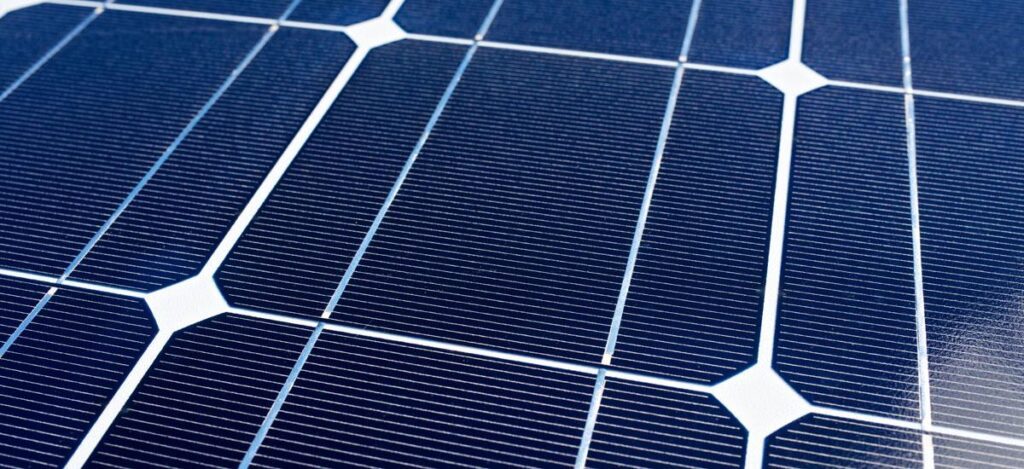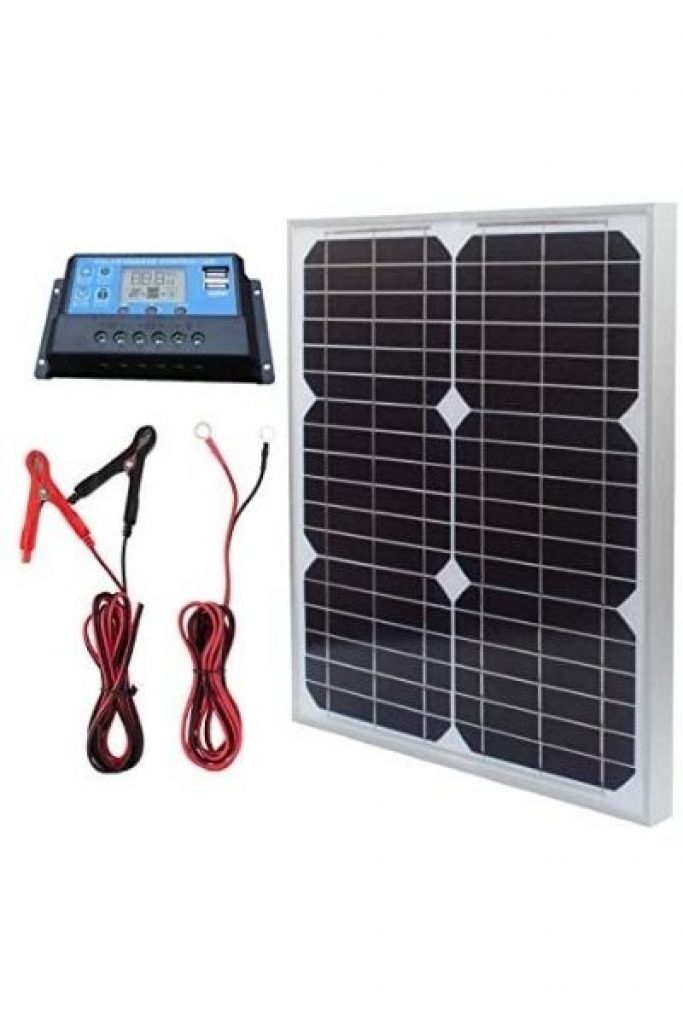In this day and age, we wouldn’t blame you for thinking about making the switch to a monocrystalline solar panel.
Although there’s nothing entirely wrong with polycrystalline solar panels, their efficiency is somewhat lacking compared to mono solar panels.
This article aims to teach you all there is to know about these more efficient solar panels and why they’re the more intelligent choice for your solar home installation.
Table of Contents
What Is A Monocrystalline Solar Panel?

A monocrystalline PV panel is a premium energy-producing panel consisting of smaller monocrystalline solar cells (60 to 72 cells).
Their superior aesthetics and efficiency make them the preferred choice for intelligent solar thinkers investing in the long term.
How Are Monocrystalline Solar Panels Made?

Each solar cell is made from a single silicon ingot, grown from some of the purest silicon.
These solar cells appear smooth, and each silicon ingot is sliced into thin wafer formats to fit into the panel perfectly.
How Is An Ingot Made?
The silicon rock is melted at 2500 °F (1371 °C), then a seed crystal is lowered into the melted silicon mush and slowly pulled up while rotating.
You could compare this process to making a hand-dipped candle, but instead of melting wax, you’re melting rocks (at a much higher temperature).
Because the silicon ingots have a rounded shape, a lot of material is lost when cutting it into the thinner required squared shape.
That is why most monocrystalline solar panels have rounded corners to assist in minifying the overall silicon waste.
Looking at older monocrystalline panels, you’ll notice that they’re made from round solar cells.

How Do Monocrystalline Solar Panels Work?
Solar panels are an amazing technology. But how do they work?
Silicon is a semiconductor material; it exhibits unique properties combining the one of a metal (conductor) and an insulant. But pure silicon doesn’t produce electricity under the sun; it needs to be altered slightly.
When the silicon rocks are melted, some positive chemical element, such as boron, is added; this process is called doping. This additive makes sure that the resulting silicon ingot has a positive potential.
Once the silicon ingot has cooled for days and sliced into thin wafers, it’s then coated on one side with a negatively charged element such as phosphorus.

The combination of positively doped silicon on one side and negatively doped silicon on the other creates what’s known as a positive and negative junction (PN junction); this is where the magical photovoltaic effect occurs!

Thin silver wires are painted onto the silicon wafers, providing a way to harness the flow of passing electricity.
How Is The Electricity Generated?
At this point, you may be asking yourself, how is the electricity generated in the first place?
When the sun shines down on the negative side of the monocrystalline solar panel, some of the negatively charged electrons are knocked loose from their atoms.
From here, they travel across the PN junction to the positive side of the solar panel, where holes are available for them to fit into.

This process results in direct current (DC) being generated — it travels through the silver wiring system of the panel and into an appliance or, most of the time, into a storage device, such as a LiFePO4 Battery.
Why Is Monocrystalline More Efficient Than Polycrystalline?
Firstly, let’s understand the maximum theoretical performance of each solar panel.
- Polycrystalline solar cells have an average efficiency of 18%, which means 18% of the sun hitting the cell is converted into electricity. Combine them in a solar panel, and you’ll get around 17 % of efficiency.
- Monocrystalline solar cells’ average efficiency is always higher (up to 23%), resulting in a solar panel efficiency of 22%
Additionally, regarding low irradiance performance, monocrystalline solar panels have a slight advantage (2%) over polycrystalline panels.
So, What’s the Reason?
Monocrystalline solar cells are more efficient than polycrystalline cells mainly because of their crystal arrangement. A single or monocrystalline solar cell enables the electrons to move much faster than in polycrystalline solar cells.

How Long Do Monocrystalline Solar Panels Last?
You can expect your monocrystalline solar panel to have an average lifespan of between 25 to 30 years.
However, it doesn’t mean that your panels will stop producing electricity altogether at the end of this period.
Instead, it means that the solar panel’s electricity production/efficiency has declined substantially (according to manufacturers), usually down to 80% of its initial specs.
For example, a 22% efficiency monocrystalline solar panel will still have an efficiency of 17.6% after 30 years!
How Long Does It Take For A Monocrystalline Solar Panel To Pay For Itself?
The amount of time it takes for your solar panel to pay for itself depends on its size, cost, and location. A 400-watt solar panel located in California would pay for itself in less than 2 years.
As of April 2022, electricity costs $0.2559 per kWh in California, as one 400-watt panel is expected to produce 730 kWh per year. As such, you can expect to save $187 annually.
Your average 400-watt monocrystalline solar panel costs roughly $290.
Considering the average lifespan of a solar panel is 25-30 years, you could expect to save about $5,000.
Note that this estimation doesn’t take into account the cost of installation.
Do Monocrystalline Solar Panels Need Maintenance?

Like all solar panels, monocrystalline panels need very little maintenance. Because there are no moving parts involved, there isn’t as much chance for wear and tear.
Our Recommendations
- Every 3 years, you visually inspect your solar panel’s mounting rails.
- Wipe your monocrystalline solar panel down every few months; clear any debris such as fallen leaves or dust build-up.
That’s about it; solar panels require very little maintenance!
Are Monocrystalline Solar Panels Better Looking Than Polycrystalline — Blue Vs. Black Solar Panels?
You might have already noticed that some solar panels display a blue hue with multiple reflections (especially the older solar panels) while others have a uniform black color.
The “blue solar panels” are made out of polycrystalline silicon. Multiple silicon crystal arrangements give polycrystalline solar panels this blue color.
On the other hand, “black solar panels” are made of monocrystalline silicon, which results in a uniform dark color.
Monocrystalline solar panels are widely considered more attractive than blue polycrystalline panels. Architects can easily integrate them into buildings (Building Integrated Photovoltaics – BIPV) in the most elegant way, such as the solar roof developed by TESLA.
What Are The Best Monocrystalline Solar Panels?
Deciding on the best monocrystalline solar panel for your campervan or household comes down to your total energy requirements.
Here is a list of our 5 best monocrystalline solar panels in the 10 to 320-watt 12-volt category.
1. Renogy Eclipse 100W Monocrystalline Solar Panel
The Eclipse is one of the preferred 100-watt solar panels on the market, and many van life travelers opt for them.
It’s made from the highest efficiency solar cells Renogy offers while weighing in at a mere 15 pounds (6 kg).
The solar cells are encased in a corrosion-resistant aluminum frame. People living close to the beach, here’s your answer.
2. ECO-WORTHY 120W Foldable Solar Panel
The 120 Watt monocrystalline solar panel from ECO-WORTHY is the perfect portable device for your camping trips.
This panel can generate about 500 Watt-hours daily under 4 hours of full sunlight.
This is enough energy to recharge your smartphone about 40 times, GoPro 50 times, laptop 4 times, and your drone 30 times.
Combining this with a portable solar generator is undoubtedly the best digital nomad solution.
3. TP-Solar 20W Solar Panel
Lightweight and affordable.
The perfect monocrystalline solar panel if you are looking to power small appliances such as courtyard lighting, solar gate openers, or water pumps in the backyard.
4. Goal Zero Nomad 10-Watt Foldable Monocrystalline Solar Panel
Weighing only 1.2 lbs and fits almost anywhere.
Take it with you hiking, fishing, camping, or whatever adventure you feel it would come in handy.
The monocrystalline solar panel will charge phones, power banks, headlamps, fitness trackers, and lighthouse lanterns.
5. Renogy 320-Watt Monocrystalline Solar Panel
This solar panel is primarily used for residential and commercial purposes.
Rooftop solar systems are the ideal way to decrease your overall electric bill.
This particular panel from Renogy can withstand high winds, up to 2400 Pa, and snow loads of 5400 Pa.
Final Thoughts
Our article shows that monocrystalline solar panels are made of high-purity, perfectly oriented silicon crystals, whereas polycrystalline panels are made of multiple individual silicon crystals.
This results in different properties for these two types of panels.
Monocrystalline solar panels are more efficient and better looking but come at a higher price.
For decades, polycrystalline solar panels have been dominating the market. However, thanks to technical improvements, the leading technology in 2022 is monocrystalline solar panels. In the meantime, polycrystalline solar panel sales are expected to decline in the coming years.






